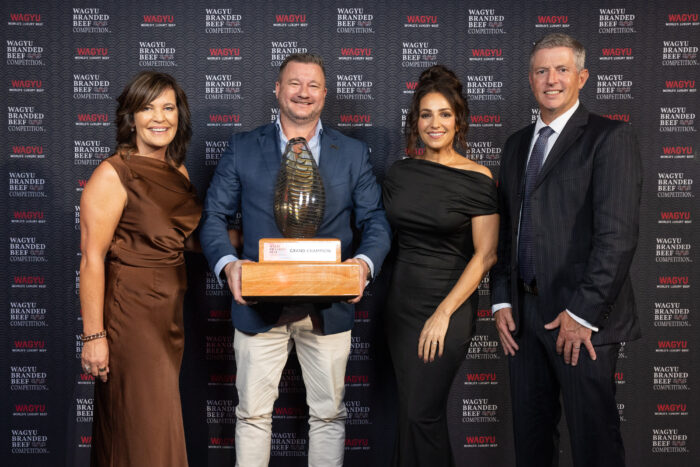Queensland-based producer takes out top honours at Australia’s premier Wagyu awards, beating out a record 91 entrants to claim top prize
The finest of Australian Wagyu beef was celebrated last night, with Sanchoku Pure Wagyu by Stanbroke taking home the prestigious title of Grand Champion of the 2025 Wagyu Branded Beef Competition (WBBC) in front of a crowd of 550 adoring steak enthusiasts.

L to R: Grand Champion partner, Ariat Australia, with Chris Woolhouse from Stanbroke, WBBC host, Ms Jess Pryles and AWA CEO, Dr Matt McDonagh.
Hosted by the Australian Wagyu Association (AWA) the WBBC is recognised as the most prestigious event of its kind in Australia and each year, takes place on the opening night of the WagyuEdge conference. This year’s competition awards evening took place in Perth, WA and showcased the exceptional quality, innovation and heritage that sets the Australian Wagyu industry apart.
Now in its 14th year, the WBBC continues to reinforce Australia’s leadership in Wagyu production, with an increasing number of premium entries reflecting the dedication and excellence of producers nationwide.
This year’s Grand Champion entry, Class 2 – Purebred Wagyu submission from Sanchoku Pure Wagyu, captivated the judging panel with its superior caramelised grilled aroma, rich umami flavour, silky melting texture and subtle buttery popcorn notes. Scoring an impressive 1028 points, judges praised it for its “exceptional balance of richness and tenderness, delivering an unparalleled Wagyu experience.”
A total of 91 world-class entries were judged by an expert panel of eight renowned food and beef industry specialists from across Australia. The competition, which has grown significantly in participation year-on-year, featured five distinct classes:
- Class 1: Fullblood Wagyu
- Class 2: Purebred Wagyu
- Class 3: Crossbred Wagyu
- Class 4: Open F1 Wagyu
- Class 5: Commercial Wagyu (Marble Score 5-7)
Entries were rigorously evaluated for visual appeal, aroma, juiciness, flavour complexity, and overall mouthfeel by a panel of over 40 judges. These lucky individuals must surely have the best job in the Australian beef industry.
As a flagship event of the WagyuEdge’25 conference, the WBBC serves as a platform to celebrate and promote the world-leading quality of Australian Wagyu beef on both national and international stages. The medals earned provide a coveted level of prestige and WBBC grand champions are able to command higher prices for their awarded beef.
Sanchoku Pure Wagyu by Stanbroke, this year’s Grand Champion producer, Chris Woolhouse, Sales EU, MENA and USA, expressed immense pride in the win;
“It’s certainly unexpected – the standard of entries here every year is incredible, so it’s very humbling to be standing here tonight holding this trophy. This is a real credit to the entire team, from paddock, right through to feedlot. They do an amazing job, and we wouldn’t be here without them.
Its also really special to see so many who use our facilities winning awards tonight too. We’re proud to have been part of their journey as well.”
The WBBC continues to highlight the remarkable progress of the Australian Wagyu sector, with producers blending time-honoured feeding traditions with cutting-edge innovation to meet the evolving demands of global markets.
Class champions of the night included:
- Class 1 Champion: Fullblood Wagyu: Signature Series by Mayura Station (Reserve Champion)
Awarded for their outstanding entry in the Fullblood Wagyu class, scoring 1016 points and noted for its “very tender, melting and juicy with a rich buttery and beefy flavour.”A flagship Australian Wagyu brand, Mayura is the most awarded entrant in the WBBC Competition. - Class 2 Champion: Purebred Wagyu: Sanchoku Pure Wagyu by Stanbroke (Grand Champion)
Recognised for their Purebred Wagyu submission, and taking home the highest score of any in the competition. Ultimately Sanchoku Pure Wagyu took home both class two and Grand Champion of the prestigious awards. - Class 3 Champion: Crossbred Wagyu: Stockyard Black by Stockyard Beef
Taking top honours in the Crossbred Wagyu category with a steak praised for its “soft and juicy, with a delicate balance of beefy aroma and subtle sweetness.” - Class 4 Champion: Open F1 Wagyu: Jack’s Creek Wagyu F1 by Jack’s Creek
Earning the title for Open F1 Wagyu with a submission lauded for its “vivid caramel notes pair beautifully with smooth texture and savoury grilled undertones.” - Class 5 Champion: Commercial Wagyu (Marble Score 5-7): Sandalwood by Lotte International
Winning the Commercial Wagyu category with an entry that showcased “a rich caramel aroma, this melt-in-your-mouth cut offers well-balanced umami and grilled undertones.”
AWA CEO Dr. Matt McDonagh commended the high calibre of entries, stating, “The WBBC continues to set the benchmark for excellence in Wagyu beef. Each year, we see new standards of consistency and quality across all classes. The calibre of this year’s entries cements Australia’s position as a global leader in premium Wagyu production — and it’s great to see Sanchoku Pure Wagyu taking the ultimate win on this global stage.”
